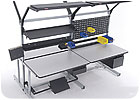
In this era of lean manufacturing and gleaming, efficient final assembly plants, it’s easy to forget the bad-old days were not so very long ago. On the one hand, manufacturing was characterized by big, grimy machines expressly designed to churn out widgets by the trainload-whether or not anyone actually wanted them. On the other, shop floor employees often had to do their work in conditions that, in retrospect, seem nothing less than medieval. Indeed, some smaller firms are still making the transition.
The following are a few examples of how manufacturers have upgraded their processes by implementing the latest in workstation technology. They span a wide spectrum of industries, but have one thing in common: In every case, by rationalizing the way their employees add value to work in progress, these companies have been able to measurably improve flexibility, efficiency and the bottom line.

By upgrading its material-handling process through the use of conveyors, trolleys and integrated workstations, a lighting manufacturer improved throughput and reduced injuries among its employees.
A Safer, More Productive Work Environment
Sovella Inc. (Kennesaw, GA) recently installed a comprehensive new manufacturing system for a company that builds electrical and electronic lighting components for the automotive and aviation industries. This manufacturer was having problems with throughput and workplace injuries because it was still using antiquated wooden workbenches and bins in its assembly operation.In particular, a number of employees were experiencing injuries as a result of having to carry cartons of subassemblies by hand to where line workers then had to reach down to retrieve them during final assembly. Workers also had to carry the finished product to a packaging area, which was equipped with an assortment of clumsy stapling and taping tools. Clearly the company had reached a point where something had to be done.
To address these issues, Sovella installed a series of its MultiLine transfer conveyors to work in conjunction with various material-handling trolleys, overhead tool rails and tool balancers, including the company’s Light/Balancer Rail, which incorporates a work light and tool balancer in a single product. The resulting assembly system eliminates nearly all the lifting and reaching workers had previously been forced to contend with.
The end result has not only been a dramatic increase in throughput, but improved worker morale, due to the fact the employees now perform their jobs in a setting that is safe, comfortable and aesthetically pleasing.
For more on the Sovella product line, call 770-424-0004 or visitwww.sovella.us.

The company’s testing area includes a “wall” of monitors mounted on a custom framework.
Accommodating Growth
Along these same lines, a computer manufacturer specializing in systems used in the financial markets industry, recently found itself having to cope with an explosion of business that threatened to overwhelm a number of different departments, including shipping, receiving, and test and assembly. The manufacturer’s products are highly customized, with each computer assembled and programmed based on a customer’s specific information needs.To streamline its manufacturing process, the company needed to upgrade its workstations so that they would be consistent throughout the manufacturing facility, yet still be capable of adapting to changing production needs. The workstations also had to be strong enough to support a variety of tools, supplies and test equipment. This latter concern was considered critical, because the company had had a number of workstations break down under the strain in the past. Finally, the company needed to install its new workstations in a timely fashion.
In the end, the company implemented a range of different workstations and workstation accessories from Production Basics (Watertown, MA). A major factor in its decision to go with the Production Basics line was the latter’s on-line 3D workstation configurator, available through the company’s web site. All of the decision makers involved in the purchasing process used this tool to view the various workstation sizes and accessories that might be appropriate to their particular needs. Managers could then view alternative configurations in the comfort of their own offices and build an ideal workstation.
In the end, the departments all agreed to go with the Production Basics C-Leg series, which is comprised of a number of different modular components, including frames, legs and work surfaces. Among other accessories, the assembly and test departments requested overhead lights; air rails for pneumatic tools; shelving for supplies and label printers; tack boards for privacy and cable troughs; and computer monitor holders to help manage the work in process. Production Basics also built a custom computer monitor mount to support an entire wall of monitors for the company’s testing area.
For additional information on Production Basics’ product line, call 800-318-2770 or visitwww.pbasics.com.
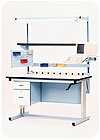
By implementing height-adjustable workstations on the shop floor, Young Windows improved throughput and reduced the number of stress injuries experienced by employees.
A Clearly Superior Work Environment
Young Windows Inc. (Conshohocken, PA) manufactures custom aluminum windows for the marine industry as well as various highway, off-highway and transit vehicles. Until recently, the technicians assembling the aluminum framing, locks and glass plates comprising the windows had to work at-literally-homemade benches that had been cobbled together out of large chunks of wood.According to Young Windows vice president Joseph Lepo, these workstations were “the kind of benches you’d work on in your basement at home, and they were extremely immobile. If we wanted to shift a workbench to another part of the department, we needed three men and a forklift to get the job done.”
To improve its work processes, the company installed 15 Ergo-Line ergonomic, height-adjustable workbenches from Pro-Line (Haverhill, MA). To accommodate Young Windows’ particular needs, Pro-Line equipped the benches with casters for mobility. Pro-line also increased the length of the workbenches from 6 feet to 8 feet to accommodate Young Windows’ larger window assemblies, some of which measure 6 feet long and 3 feet high.
“With our new system in place, our people and our workbenches can move to where the work needs to get done,” Lepo says. “Benches can be moved mid-shift without disrupting workflow. Every bench is partnered with a roll-around tool box that helps free up space and keep essential tools readily accessible.”
According Lepo, the height adjustability of the benches has played a huge role in improving workplace ergonomics. The company’s assembly department includes approximately two-dozen people working in two shifts, with operators continually switching from bench to bench. Given the large size of the company’s window assemblies and the varying heights of the company’s employees, keeping the work within easy reach of each person was critical to eliminating potential stress injuries.
“Since we’ve switched to the Pro-Line workbenches, we’ve seen both a clear increase in productivity as well as improved product quality,” Lepo says.
For more on the Pro-Line product line, call 978-521-2600 or visitwww.1proline.com.
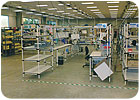
Lightweight, U-cell workstations are easy to reconfigure and position multiple tasks so that everything is close at hand for operators.
Valve Manufacturer Goes With the Flow
As part of an ongoing focus on lean manufacturing, a manufacturer of precision, high-pressure fluid valves, fittings and filters realized its workstations could stand some major improvement.Employing approximately 250 operators, the facility manufactures a wide range of products used in scientific measurement and medical analytical equipment. These are typically assembled from small, light, precise parts in near clean-room conditions. Unfortunately, the company’s existing equipment consisted of various off-the-shelf workstations, benches and tables, many of which had load capacities far in excess of what was needed, making them extremely difficult to move. This, in turn, made it difficult to adapt to changes in product demand.
To remedy the situation, the company revamped its assembly area by building a series of flexible workcells using plastic-coated steel pipes and joints from Creform Corp. (Greer, SC). In addition to supplying the basic hardware, Creform provided a set of basic workstation and support-structure designs that could be quickly reconfigured as needed. Among these is a basic U-cell workstation design that allows operators easy access to a number of different cell processes, so that employees no longer have to move around a lot when doing their jobs.
The plastic-coated steel pipe sections that make up the cells are assembled using metal joints that tighten onto the pipe sections via a threaded fastener. The finished assemblies are light enough to be easily moved. This simple and flexible construction technique allows the valve manufacture to easily alter, expand or dismantle the cells in a matter of hours-or even minutes-to suit production changes.
In addition to the basic cells, the company has also implemented a variety of Creform carts, stands and racks to replace the motley assortment of equipment it relied on in the past. Like the cells’ pipe and joint framework, these units can be readily reconfigured as necessary, while the consistent form and color coordination of the workstations and handling structures enhance the appearance of the manufacturing area.
For more on workstations from Creform Corp., call 800-839-8823 or visitwww.creform.com.

By collaborating on the design of a “core bench,” operators created a series of workstations that can be used through their assembly facility.
Workstations Part of Company Move
A manufacturer of energy control systems for aircraft engines, industrial engines, turbines and electrical power equipment, recently upgraded much of its production equipment, including the workstations it uses, in the course of moving its corporate headquarters.Many of its products are large and impossible to produce using automated systems, so the company relies on a large workforce to perform manual assembly and inspection. It also uses many different workstations to accommodate the variety of assemblies it produces.
In selecting a new line of workstations, the company wanted something that would be flexible enough to accommodate the nine different departments that would be using it. The result was a kind of “core bench,” created by operators in conjunction with workbench manufacturer IAC Industries Inc. (Brea, CA). Each core bench features motorized height adjustment and locking casters, so that operators can quickly rearrange floor plans. The benches are also equipped with upright framing, which can be used to mount overhead lighting to supplement the ambient light in the facility.
With regard to additional accessories, many operators elected to go with wire shelving, because it does not collect dust the way solid metal shelves do. A number of the departments also chose to install electrical service and metal backsplashes to keep parts from rolling off the back of the work surfaces; multi-bin cup h olders for parts storage and presentation; uprights with quick-disconnects for air tools; dry-write isolation screens for recording daily production goals; swing-arms for mounting keyboard and flat panel displays; and fixed-position footrests for shorter workers to use when seated.
For more on IAC Industries, visitwww.iacindustries.comor call 714-990-8997.
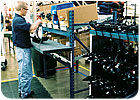
The Flow Cell, seen to the right in the picture above, allows operators to replenish this workstation without interrupting production.
Picking Stations Promote Lean Manufacturing
Automotive supplier Android Industries (Shreveport, LA) applies lean manufacturing principles to every facet of its production processes, including the hardware it uses for assembly and parts picking. Central to this effort has been the use of mobile Flow Cell workstations from UNEX Manufacturing Inc. (Jackson, NJ), which allow assembly-line operators to pick components quickly and easily.With its vertical orientation, a correctly configured Flow Cell unit can improve space utilization by 50 percent and increase pick rates up to 30 percent. “We can put four days worth of material on the Flow Cell and not have to replace material,” says Android Industries lead engineer Mark Greer, describing these efficiencies in concrete terms.
Flow Cells are typically used “line side,” to maintain a ready supply of components for picking. They can be quickly reconfigured to accommodate product and process changes, and promote ergonomic safety by angling parts toward the picker. They also allow workers to replenish a workstation without interrupting ongoing production. Finally, they are easy to assemble with simple hand tools, so that manufacturers can quickly have them up and running.
“[The system] does what it’s supposed to do and doesn’t take up a lot of floor space,” Greer says. “We ordered 22 Flow Cell units, and they all went together in one day.”
For more on UNEX workstations, visitwww.unex.comor call 800-695-7726.

Engineers at Koenig Apparate and Turmix AG used proprietary design software from Bosch Rexroth to create 22 workstations that meet their specific production needs.
Manual Production Systems ‘Fix' Problem
To improve service and reduce costs, appliance manufacturers Koenig Apparate AG and Turmix AG, both subsidiaries of Diethelm Keller Group (Zurich, Switzerland), recently combined their household appliance service centers into a single new facility in Bassersdorf, Switzerland.Although the center performs repairs, as opposed to manufacturing products from scratch, the scale of the operation is such that engineers still applied lean manufacturing principles to optimize its efficiencies. In all, the center processes approximately 500 different appliances, ranging from coffeemakers to grills. Every year it consumes more than 30,000 replacement parts as repairs are made on some 40,000 items.
To optimize their repair processes, Turmix and Koenig Apparate engineers installed a series of workstations and material-handling units from the Manual Production System (MPS) line of products manufactured by Bosch Rexroth Corp. (Buchanan, MI). The MPS line includes a variety of function modules that can be mixed and matched to suit a particular manufacturer’s production needs. The system includes workstations and a wide range of accessories, like flow-rack systems, material shuttles and containers, to facilitate material flow and linking.
Bosch Rexroth also offers MPScalc planning software to help customers define exactly what they need, while an integrated price calculator provides upfront pricing. Using the software, company engineers created 22 identical manual workstations, each with a height-adjustable, rotating tabletop, as well as a number of tool holders and parts containers. The appliances to be repaired are supplied via a passive roller conveyor based on the Rexroth TS2plus transfer system. The conveyors are located behind the worktables so the appliances waiting to be repaired won’t get in the way of work in progress.
For more on MPS workstations, call 800-REXROTH or visitwww.boschrexroth-us.com.
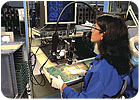
REDCOM Laboratories recently upgraded its old homemade workstations to increase ease of use and flexibility.
Workstation Facilitates High-volume Transition
REDCOM Laboratories (Victor, NY) manufactures switching, communications and emergency response systems for the government and private sector. Founded in 1978, the company spent years as a high-mix, low-volume manufacturer. However, increasing demand for its products eventually compelled the company to upgrade its production facilities. Central to this effort was a new set of workstations, which replaced a series of homemade wooden benches that were somewhat crude, to say the least.“These benches were not suitable for the work that needed to get done,” says REDCOM director of manufacturing, Steve Husband. “They were deficient in many areas, including ergonomic comfort, lighting and easy access to tools and parts. In order to accommodate our transformation to a tight, dynamic type of manufacturing facility, we needed to provide our assemblers and technicians with the right tools. We recognized that our old workstations could no longer meet our needs.”
Ultimately, the company installed a number of Arlink 8000 modular workstations from Lista International Corp. (Holliston, MA). According to Husband, REDCOM went with the Arlink line because of its cost, ergonomics and modularity.
“Our facility is dynamic. Volume demands are always changing. We constantly need to move and reconfigure the workstations to accommodate specific lines and workcells,” he says.
According to Husband, since REDCOM implemented its new workstations, the company has seen a clear improvement on the assembly floor. “We are able to sustain a higher level of work, with the same amount of personnel. The difference is tied to a combination of factors, but the workbenches play a substantial role in improved productivity,” he says.
For more on Lista International, visitwww.listaintl.comor call 800-722-3020.